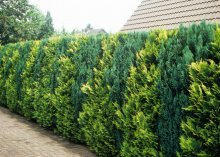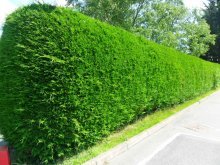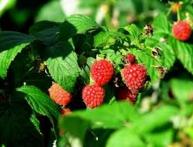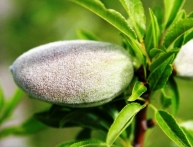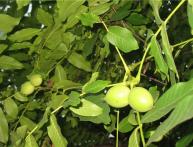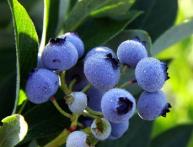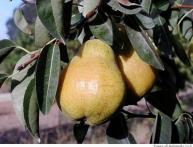A hedge made of juniper is beautiful and practical
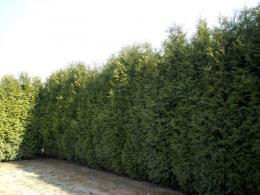
Hedges of ornamental plants in personal plots always look unusually picturesque. In addition, living border strips are very functional - they reliably protect personal territory from prying eyes, uninvited guests and unnecessary winds. Evergreen fences made of coniferous trees, in particular juniper, look especially impressive.
Content
Advantages of juniper hedges
Junipers (a genus of the Cypress family) have more than 70 species - from creeping shrubs to large trees. Landscape designers willingly use these popular coniferous plants in group compositions, in solo form, and as decorative fences. To create a living border of garden plantings, various varieties of common, Virginia or Cossack junipers are most often taken.
The color of juniper hedges, depending on the color of the needles, can be juicy green, light, golden yellow, or gray. Junipers are not only beautiful - they are also unpretentious, durable, frost-resistant and easy to care for. A high-quality juniper fence can perform many functions:
- hide the territory from curious neighbors
- mark the boundaries of individual zones of the personal plot
- improve its landscape decorative background
- enrich the air with pine aroma and phytoncides
- revive the monotonous colors of the winter garden
- improve soil composition and prevent slope collapse
A hedge can take a wide variety of forms. It depends on the desire of the owner, on the type and variety of juniper and the density of planting. Borders and medium-high fences are made from shrubby junipers, and high living (as they say, “cypress”) walls are made from tree-like junipers.
Coniferous hedges can be shaped by trimming or left freely growing. Uncut lines look more relaxed, while cropped lines look good due to their strict shapes.
Planting a hedge
It is better to purchase conifer seedlings from a local nursery - there they are already acclimatized and adapted to the conditions of the area. Young, medium-sized plants are preferred as they take root better. Subsequently, it is easier for them to form a root system and close the crowns.
When transported in pots or containers, the roots of seedlings are better preserved. When purchasing dug up seedlings, you need to make sure that their root system is intact and that there is a moist earthen ball. Important. hedge from juniper must receive a sufficient amount of sunlight, otherwise the bushes will be loose and lose their decorative effect.
Only some varieties of common juniper tolerate light shading. The best time for planting is spring, before the buds open. The planting season can be extended until July if the pets are delivered to the site in containers.
Autumn planting is also allowed - but only until mid-September, so that the plants have time to take root by the winter. The process of creating a single-row hedge consists of several stages.
The area for the living fence is first dug up and cleared of weeds. Markings are made using a cord and pegs. A trench is dug along it, up to 70 centimeters deep and 40 centimeters wide than the diameter of the seedling’s earthen ball.
The planting should be close enough so that the crowns close together in the third year, but the plants do not subsequently suffer from lack of moisture. Therefore, they are planted at a distance of at least 50 cm from each other. It is recommended to keep the distance between the tree-like forms of juniper no more than one meter, otherwise the “adult” hedge will look like an alley.
Drainage made of gravel, broken brick or expanded clay is poured into the bottom of the trench. Add a mound on top compost, mixed with excavated soil. Place the seedling in the center of the hole, spreading the roots evenly on the mound, and cover it with fertile soil. The base of the seedling and the root collar should be at soil level or slightly higher. Carefully, so as not to tear off the roots, compact the soil with the toe towards the plant.
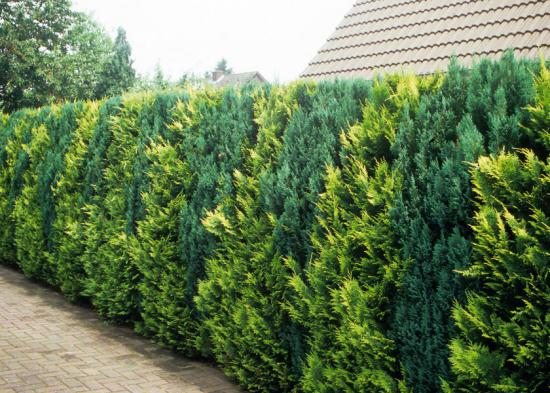
Give abundant watering - up to two buckets of water for each specimen. Mulch the tree trunk circle with peat or rotted sawdust to prevent the soil from drying out and maintain optimal temperature conditions in it. Compact and non-spreading varieties of junipers can be planted in a two-row manner, in a checkerboard pattern, for greater hedge density.
Juniper care
Junipers are quite unpretentious, but love light and moist, loose soil. During the first time after planting, pets especially need regular watering. In extreme heat, it is advisable to “wash” the plants once a week by sprinkling. Mature plants do not require regular feeding. Young ones can be fed in early spring by adding nitroammophoska (30 g per 1 sq. meter).
Weeds should be constantly removed from the “foot” of the living fence. Weeds compete with cultivated plants for moisture and nutrition, so the hedge runs the risk of losing its decorative properties. The strong rays of the spring sun, reflected from the snow cover, can damage the tender young pine needles. Therefore, it is advisable to cover young animals with burlap from possible burns.
Hedge trimming
In order for the hedge to be dense, with the crown lowered to the ground, the plants that make it up must receive sufficient light, moisture and nutrients. The most suitable time for cutting is spring, before the buds open, that is, the beginning of the active growth phase of shoots.
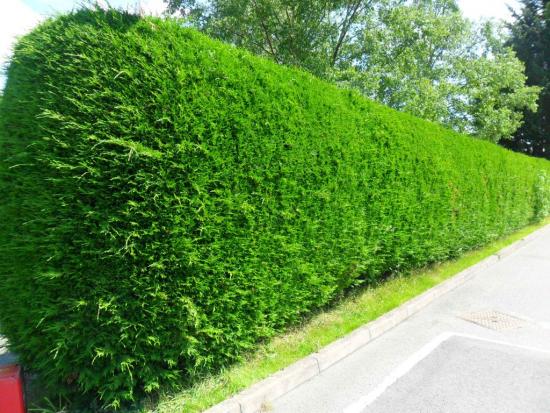
Conifers with strong shoot formation are also pruned in August, no later, giving the cuts a chance to heal before winter. Junipers in general grow quite slowly; the initially spectacular crown does not require special trimming. Therefore, the first pruning after the first year of planting is light, neat, on the sides.
The tops of the plants are trimmed constantly when they reach the desired height. This procedure produces strong lateral growth of shoots, which helps fill gaps and gaps in the row. To do this, pull the rope on the pegs at the required height. For pruning young hedges use regular garden shears. More powerful special tools will be needed later.
A durable juniper fence is not only a picturesque designation of the boundaries of your own territory. The evergreen fragrant hedge really lives - it grows, blooms, is decorated with fruits, and changes shades.Created once and not requiring complex care, it will delight more than one generation with its decorative effect.
Video about juniper hedges:

